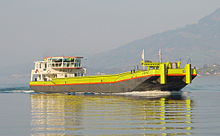Ledischiff

Ledischiff is the common name of a cargo ship for bulk cargo (often gravel transport) on Swiss lakes in Eastern Switzerland . The ships on Lake Lucerne in Central Switzerland are called Nauen . Around 200 such cargo ships are on the move on twelve Swiss lakes. Some former cargo ships are also rented out for events with a structure similar to a party tent.
Origin of name
The cargo ship for freight mail without a keel is called Ledi because of the load; the Ledi may have been the ancient dialect for the charge. An earlier measure for “e Ladig” (dialect) was “e Ledi”. It was not about a specific amount, but about the transport medium; a "Ledi" for man and horse was not the same as a "Ledi" for a carriage or a ship. A council protocol in Schaffhausen around 1530 mentions that the court servants should "have an eye on the Ledines so that they are not overloaded".
In the Urnerland the name "Chiesnaue" (dialect) is known, with the word origin "Nauen".
meaning
Historically, the transport of goods on the Swiss lakes was of outstanding importance, since all transalpine goods traffic used the lakes; There was no other way to access the Gotthard at Lake Uri , but from Zurich all goods were transported up to the construction of paved roads on the lake and reloaded again on the way to the Alps at Lake Walen. Some of these rowed boats had sail support. Only with the construction of the railways was transit traffic handled without reloading.
In 1914 it was still easiest to take the ship from Weggis to Luzern to Markte. So-called tow ropes were used until the 1950s to transport large cattle and other cargo, with the steamships on Lake Lucerne having up to three such ropes in tow. Particularly noteworthy is the loading of standard-gauge railway wagons onto the Nauen in Lucerne from 1860 onwards: this enabled the Centralbahn wagons to be transported directly to a company near the lake without reloading, which turned these Nauen into actual ferry boats .
The main remaining load task for ships on the lakes consists of the shifting of bulk cargo and a few special tasks such as sea cleaning depending on the construction options on the ship. (Sometimes pontoons are used for this type of work .) Ledish boats for gravel can be found on several lakes:
- Up until 2011, they transported railway ballast on Lake Walen , which they picked up from the quarry east of Betlis ( Amden municipality ), to the Mühlehorn train station on the opposite side of the lake .
- Every year 300,000 tons of gravel, sand and stones are transported on Lake Zurich . The Kibag has on Lake Zurich for several Landequais for their concrete plants, including in the city of Zurich in Wollishofen, where their headquarters is located.
- In front of the Reuss delta in Lake Uri, a huge dredger is floating, which is able to load the gravel onto the ships, sorted by grain size. Loading a ship with 500 tons of gravel takes up to six hours.
Special tasks remain for the smaller Nauen, at least the “Stauffacher”, a Nauen on Lake Lucerne, but it is used both as a work boat and as an excursion boat for clubs.
Accidents
The fully loaded gravel transfer ship Brisi on the Walensee sank in April 2006 within seconds. After two months, the ship was recovered from a depth of around 130 meters. It was not unimportant that the entire cargo was tipped onto the seabed when the ship sank. The gravel load of such a larger Ledischiff is at least 300 tons. The reason was the open inspection hatches, through which water from a leak could penetrate unhindered into all other bulkheads.
Wrecks
There are several sunken Ledischiffs in the Swiss lakes. Some of them are easily accessible for divers . Popular diving spots are, for example, the so-called "Lediwracks", two Ledi ships that lie between Mols and Walenstadt at a depth of around 30 meters in the Walensee. The Naue "Bruno" near Brunnen was sunk especially for divers in Lake Lucerne.
Web links
- Description and photo (PDF; 38 kB)
Individual evidence
- ↑ cf. Party ship "Max" and its history since 1914
- ↑ ( Page no longer available , search in web archives: History of the Nauen on Lake Lucerne (PDF) )
- ↑ Walter Bernet: Leisurely, but efficiently . In: Neue Zürcher Zeitung . No. 200 , August 29, 2012 ( article on NZZonline ).
- ^ Arthur Honegger: Ledischiff-Bergung aus Walensee. In: Schweiz Aktuell. June 15, 2006, accessed April 23, 2020 .
- ^ Daniel Mate: Mols, Lediwracks. Walensee. In: Dive Site Directory. Swiss Divers, February 16, 2010, accessed April 23, 2020 .
- ↑ Wreck Bruno - Fountain | SWISS DIVERS


